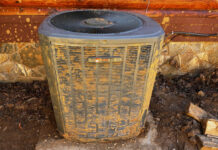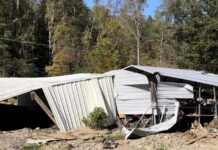Using Your Generator
Generators should never be used indoors or in another enclosed space because their exhaust can kill you from carbon monoxide poisoning. In fact, when I set mine up, I point the exhaust away from the house and we keep our nearby windows closed.
As I alluded earlier, DO NOT run your generator all day, but do so a few hours at a time. Whether you have a whole-house generator or a medium-sized portable generator, my advice is to run them as darkness falls and approximately 12 hours later, or roughly every morning and every night. By running them at night, you extend your day, allow people to read, prepare dinner, and get ready for bed, and perhaps enjoy some entertainment with some semblance of normal lighting. In the morning, you can shower, cook, maybe run a load or two of laundry. (Don’t run an electric dryer, use a clothesline instead).
The key to intermittent generator use is to run it enough to keep the food in your freezer from thawing and the food in your refrigerator from spoiling. What we’ve found works with our upright freezer (which is set at zero degrees F) is that you can start with it at zero degrees and run the generator when it reaches 20 degrees until it goes back down to zero. You can keep your fridge in a band between 33 degrees and 40 or 42.
It’s important to note that frozen food kept at zero degrees will last longer than food stored at 20 degrees, but the warmer temperature will not harm the food and will not cause it to thaw. So our ultimate goal is to keep the contents of your freezer frozen so that they can feed you for several weeks or longer and not go to waste wither the food in it or the limited amount of gasoline you have on hand.
Food that thaws — meaning that the ice or water crystals in it are no longer solid — should not be re-frozen but should be consumed or canned immediately.
Powering the Well
If you have a well and need power to pump water, we would advise you to run the well pump for a short period of time and run all the water-consumer devices you need during that period. This would include taking a shower, doing laundry, cleaning dishes, flushing toilets, etc. Fill up empty containers while you are running the well and then use them for water until the next time you run the well.
The Noise Factor
If you are in a residential neighborhood with other houses nearby keep two things in mind:
First, generators make a fair amount of noise and your neighbor will probably not appreciate it if you run yours late at night, especially if it is a reminder that they don’t have one.
Second, if you have a generator and someone else does not, they may resent you. Generators are often stolen, so get a good bike chain or other lock and chain yours to something that makes it difficult steal.
If you have sufficient power and enough extension cords, maybe offer your closest neighbor the chance to plug in and keep their fridge running, too. That will build goodwill and they will suddenly find the sound of your generator far less offensive.
Plugging In
There are plenty of articles and videos on how to set up your generator, so I will simply recommend you review the owner’s manual and then read an article or view a video one specific to your brand and model. But when it comes to attaching your generator to your house, there are two methods: Professionally wired vs extension cords.
Your best bet, and probably the only one if you have a 240 volt well pump, is to pay an electrician to set up a generator switch and panel in your home. This results in a manual switch that directs your generator power to a few pre-selected circuits. This is recommended if you have frequent power outages and expect to use your generator more than twice a year.
If your power outages are either very short – just a few hours – or very rare, then you can probably get by with extension cords. I personally run extension cords to the room where I need power and then plug in a UPS to further condition the power and to help protect whatever device you plug in. It also gives you multiple outlets.
Let me add that electrical cords are not recommended for powering your well pump.
Don’t Forget to Recharge
When I use a generator, I plug in a 700 VA uninterruptable power supply that has eight outlets and 2 USB ports. This does three things:
- It gives me multiple outlets
- It allows me to recharge two or more electronic devices
- And it smooths out any power dips or surges
If your generator is running only a few hours per day, remember to plug in phones, tablets, laptops, power tools, flashlights and any other rechargeable items. These generally take very little power but will be extremely useful for those hours when your generator is off.
Generator Storage and Maintenance
Many modern generators have a censor that shuts off the engine when the oil runs low, but its best to check your dip stick every time you use the generator. Consult your user manual to determine how often you should change your oil. (Personally, I’ll go over the recommendation by four hours if the oil looks clean, but I won’t go over it by 12 or more – it’s just not worth it.) Stock a spare spark plug, oil filter, oil, and other consumables.
When you put a gasoline-powered generator away, it’s best to run it to empty, or at least to purge the fuel line. Some people will warn you that this could cause drying and cracking of the line, but it beats running the generator every few weeks, which is the alternative and ensures that the fuel won’t gum up your engine. I also recommend using a fuel preservative for all your stored gas.
After you run the engine dry, pull the cord or crank it, if it is electrical start, a couple times to get the last of the gasoline out of the carburetor. Leaving gasoline in a small engine destroys more of them than anything else.
Be Safe
Anything that can produce a few thousand watts of power is not a toy. Read the owner’s manual and follow all instructions. Never use your generator indoors or in an enclosed space. Do not over load it. Finally, use common sense.






